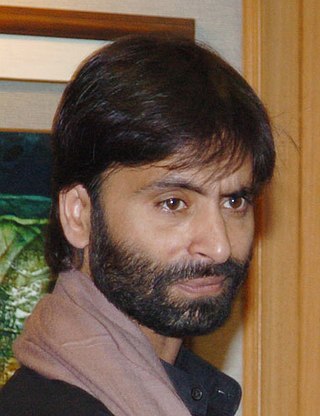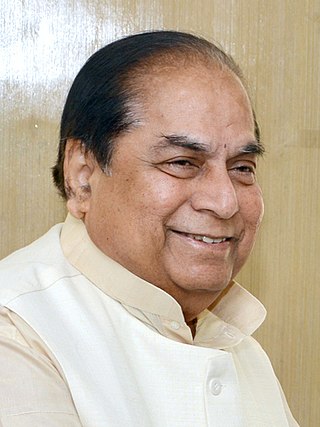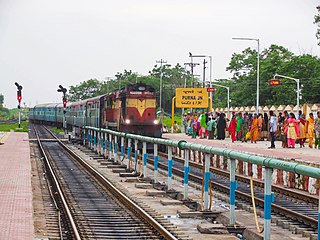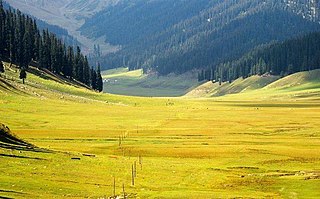Related Research Articles

Jammu and Kashmir was a region formerly administered by India as a state from 1952 to 2019, constituting the southern and southeastern portion of the larger Kashmir region, which has been the subject of a dispute between India, Pakistan and China since the mid-20th century. The underlying region of this state were parts of the former princely state of Jammu and Kashmir, whose western districts, now known as Azad Kashmir, and northern territories, now known as Gilgit-Baltistan, are administered by Pakistan. The Aksai Chin region in the east, bordering Tibet, has been under Chinese control since 1962.

The insurgency in Jammu and Kashmir, also known as the Kashmir insurgency, is an ongoing separatist militant insurgency against the Indian administration in Jammu and Kashmir, a territory constituting the southwestern portion of the larger geographical region of Kashmir, which has been the subject of a territorial dispute between India and Pakistan since 1947.

Baramulla, also known as Varmul in Kashmiri, is a city and municipality of the Baramulla district of the Indian union territory of Jammu and Kashmir. It is also the administrative headquarters of the Baramulla district, located on the banks of the River Jhelum downstream from Srinagar, the summer capital of Jammu and Kashmir. The town was known as gateway of Kashmir, serving as the major distribution centre for goods arriving in Kashmir valley from Punjab through Muzaffarabad and then distributed along the Jhelum Valley Road towards Banihal.
The Jammu–Baramulla line is a railway track being laid to connect the Kashmir Valley in the Indian union territory of Jammu and Kashmir with Jammu railway station and thence to the rest of the country. The 338 km railway track will start from Jammu and end at Baramulla. It comes under the jurisdiction of the Firozpur railway division of Indian Railways's Northern zone. Part of this railway route from Udhampur to Baramulla is known as Udhampur-Srinagar-Baramula Rail Link (USBRL). The 359 m (1,178 ft) high Chenab Bridge lies on this line, which is the highest railway bridge in the world. The total project cost in 2022 was INR28,000 crore. Construction of the route faced natural challenges including major earthquake zones, extreme temperatures and inhospitable terrain.
Handwara is a town in Kupwara district of Jammu and Kashmir, India. It is located on Baramulla-Handwara National Highway NH-701 and is governed by a municipal committee.
Kupwara is a city, District headquarter and a municipal council in Kupwara district in the Indian union territory of Jammu and Kashmir.

Yasin Malik is a Kashmiri separatist leader and former militant who advocates the separation of Kashmir from both India and Pakistan. He is the chairman of the Jammu Kashmir Liberation Front, which originally spearheaded armed militancy in the Kashmir Valley. Malik renounced violence in 1994 and adopted peaceful methods to come to a settlement of the Kashmir conflict. In May 2022, Malik pleaded guilty to charges of criminal conspiracy and waging war against the state, and was sentenced to life imprisonment.

Kupwara district is an administrative district of Indian-administered Jammu and Kashmir in the disputed Kashmir region. It is one of the 10 districts located in the Kashmir Valley Division of Indian administered Kashmir. The Pohru River and Mawar river are two main rivers in the district. Both of them meet Jhelum river in Baramulla district.

The Khillari is a cattle breed. It is a member of the Bos indicus sub-species, native to Satara, Sangli and Kolhapur regions in Maharashtra and Bijapur, Dharwad and Belagavi districts of Karnataka in India. The breed is well adapted to the area's tropical and drought-prone conditions. They are favoured by the local farming community due to their ability to handle the hardships of farming. The breed is in decline, mostly due low milk yield, which offers an alternate income stream to a farmer.

Mehrajuddin Wadoo is an Indian professional manager and former footballer. During his playing days, Wadoo played for clubs such as Mohun Bagan, East Bengal, Salgaocar, Pune City, Chennaiyin, and Mumbai City. He also represented the India national team from 2005 to 2011.

Bandipore district is an administrative district of Indian-administered Jammu and Kashmir in the disputed Kashmir region. It is one of the 20 districts in the Jammu and Kashmir. Bandipore town is the administrative headquarters of the district. Bandipore is located in the foothills of the snow-clad peaks of Harmukh overlooking the shores of Wular Lake and has produced hundreds of scholars and intellectuals. The district is known for its tourist places such as Wular Vintage Park, Athwatoo and Gurez valley. Before 1947, this town was a big trade and literary centre of Kashmir. This district was carved out from the erstwhile Baramulla district in 2007. The district is bounded by Kupwara district from the north, Baramulla district from west,Ganderbal district from the east, Kargil district in Ladakh, Neelum District in Pakistan-administered Azad Kashmir and Astore district in Pakistan-administered Gilgit-Baltistan. Bandipore district is the only district in Kashmir Division that shares border with Pakistan-administered Gilgit-Baltistan region. This district occupies an area of 398 km2. The district has a population of 392,232 as per 2011 census.

Dnyandeo Yashwantrao Patil is a former Indian politician, best known as the governor of Bihar, West Bengal and Tripura. He was a leader of the Indian National Congress from Maharashtra state.
Human rights abuses in Jammu and Kashmir range from mass killings, enforced disappearances, torture, rape and sexual abuse to political repression and suppression of freedom of speech. The Indian Army, Central Reserve Police Force (CRPF), and Border Security Personnel (BSF) have been accused of committing severe human rights abuses against Kashmiri civilians. According to Seema Kazi, militant groups have also been held responsible for similar crimes, but the vast majority of abuses have been perpetrated by the armed forces of the Indian government.

Chandrakant Bacchu Patil is an Indian politician and the Higher and technical education minister of Maharashtra state in the present Government of Maharashtra. Chandrakant Patil was the Maharashtra state President of Bharatiya Janata Party (BJP) from 2019 to 2022.

Purna Junction railway station is a main railway station in Parbhani district, Maharashtra. Its code is PAU. It serves Purna city. The station consists of four platforms. Purna has rail connectivity with Manmad, Aurangabad, Jalna, Nanded, Parbhani, Parli Vaijnath, Latur, Osmanabad, Gangakhed, Mudkhed, Adilabad, Nagpur, Basar, Nizamabad, Nasik, Dhanbad, Mumbai, Delhi, Pune, Miraj, Daund, Mahbubnagar, Kurnool, Kadapa, Renigunta, Tirupati, Katpadi, Erode, Madurai and Kachiguda.,

Adhik Kadam is an Indian social entrepreneur and philanthropist. He is on a peacebuilding and peacekeeping mission, working in the conflict zones of Jammu and Kashmir. Kadam has completed a master's degree in political science. He is a co-founder and the chairman of Borderless World Foundation, which is an NGO that works for the deprived and victimized people of the border areas of India. The NGO runs four orphanage homes for girls in four districts of Jammu and Kashmir.

The Bangus Valley official name Bungus Valley is located in Kupwara District of Indian Administered Jammu and Kashmir. It is West of Handwara town. It is situated in the Pir Panjal range and is known for its breath-taking natural beauty, including snow-capped mountains, lush green forests, and crystal clear streams. It has got two ways, one from Kupwara side which is 42 kms away from main town Kupwara and other from handwara side which is 29 kms respectively.Both the roads are almost completed.
Borderless World Foundation (BWF) is a non-profit, non-governmental organization registered under India's Societies Registration Act, 1860. Working in Jammu and Kashmir, along the conflict-riven border region in between India, Pakistan & China, BWF has rescued hundreds of girls orphaned in the conflict along the India-Pakistan border. BWF carries out a variety of activities, including disaster relief and emergency medical support for the community and rescuing children left orphaned by the ongoing conflict.

Stone pelting in Kashmir refers to stone throwing by Kashmiris on the Indian forces and Jammu and Kashmir Police deployed for crowd control in Jammu and Kashmir to support the separatists, insurgents. In the local language, it is termed as "Kanni Jung", which means fighting with stones and the stone pelters are called as Sangbaaz or Pathraw Player. However, in the recent past the number of stone pelting has dropped significantly.

Indian Army operations in Jammu and Kashmir include security operations such as Operation Rakshak, which began in 1990, Operation Sarp Vinash in 2003 and Operation Randori Behak in 2020. Other operations include humanitarian missions such as Operation Megh Rahat and operations with a social aim such as Operation Goodwill and Operation Calm Down. The Indian Army works in tandem with the other arms of the Indian Armed Forces and security forces in Jammu and Kashmir such as during Mission Sahayata or joint operations.
References
- ↑ "pune_kashmir.wmv". YouTube. 7 July 2012. Retrieved 10 December 2016.
- ↑ "Daughter of Violence". Renderyardmedia.com. 14 September 2009. Archived from the original on 20 December 2016. Retrieved 10 December 2016.
- ↑ "The Grace Of Charity". Kashmir Life. 15 August 2011. Retrieved 10 December 2016.
- ↑ "Justine Hardy". Justine Hardy. Archived from the original on 21 December 2016. Retrieved 10 December 2016.
- ↑ "Perspective: The Children of the Valley". Humanrightsdefence.org. Archived from the original on 1 December 2017. Retrieved 10 December 2016.
- ↑ Disjuncture in Law, Policy and Practice: The Situation of Child Welfare in India’s Conflict Affected Regions Archived 12 April 2018 at the Wayback Machine
- ↑ Sadia Raval (23 September 2009). "Basera-e-Tabassum (Kashmir) – Indian Muslims". Indianmuslims.in. Archived from the original on 20 December 2016. Retrieved 10 December 2016.
- ↑ "Basera-e-Tabassum on Vimeo". Vimeo.com. 14 April 2014. Retrieved 10 December 2016.
- ↑ "Project Details". Asha for Education. Retrieved 13 December 2016.
- ↑ "Films of hope, peace thrill J&K children - ANDHRA PRADESH". The Hindu . 17 November 2011. Retrieved 10 December 2016.
- ↑ "BeT Education Tour". YouTube. 29 December 2011. Retrieved 10 December 2016.
- ↑ "Shooting Kashmir on Vimeo". Vimeo.com. 27 March 2014. Retrieved 10 December 2016.
- ↑ "Archived copy" (PDF). Archived from the original (PDF) on 3 March 2019. Retrieved 10 December 2016.
{{cite web}}: CS1 maint: archived copy as title (link) - ↑ "Harmony Org". Archived from the original on 21 December 2016. Retrieved 10 December 2016.
- ↑ "City girl lights up the life of Kashmiri kids - Indian Express". archive.indianexpress.com.
- ↑ "Kids from violence-torn Kashmir preach peace". Epaper.timesofindia.com. 4 January 2010. Archived from the original on 21 December 2016. Retrieved 10 December 2016.
- ↑ Inam Ul Haq (2 May 2016). "From orphanage to social entrepreneurship: LoC girls' mission 'Happy Choice'". Greaterkashmir.com. Retrieved 10 December 2016.
- ↑ List for certificatesnic.in Archived 19 June 2009 at the Wayback Machine
- ↑ "GOC visits orphanage". M.greaterkashmir.com. Archived from the original on 20 December 2016. Retrieved 10 December 2016.
- ↑ "How Green is My Valley - Indian Express". Archive.indianexpress.com. 12 November 2011. Retrieved 10 December 2016.